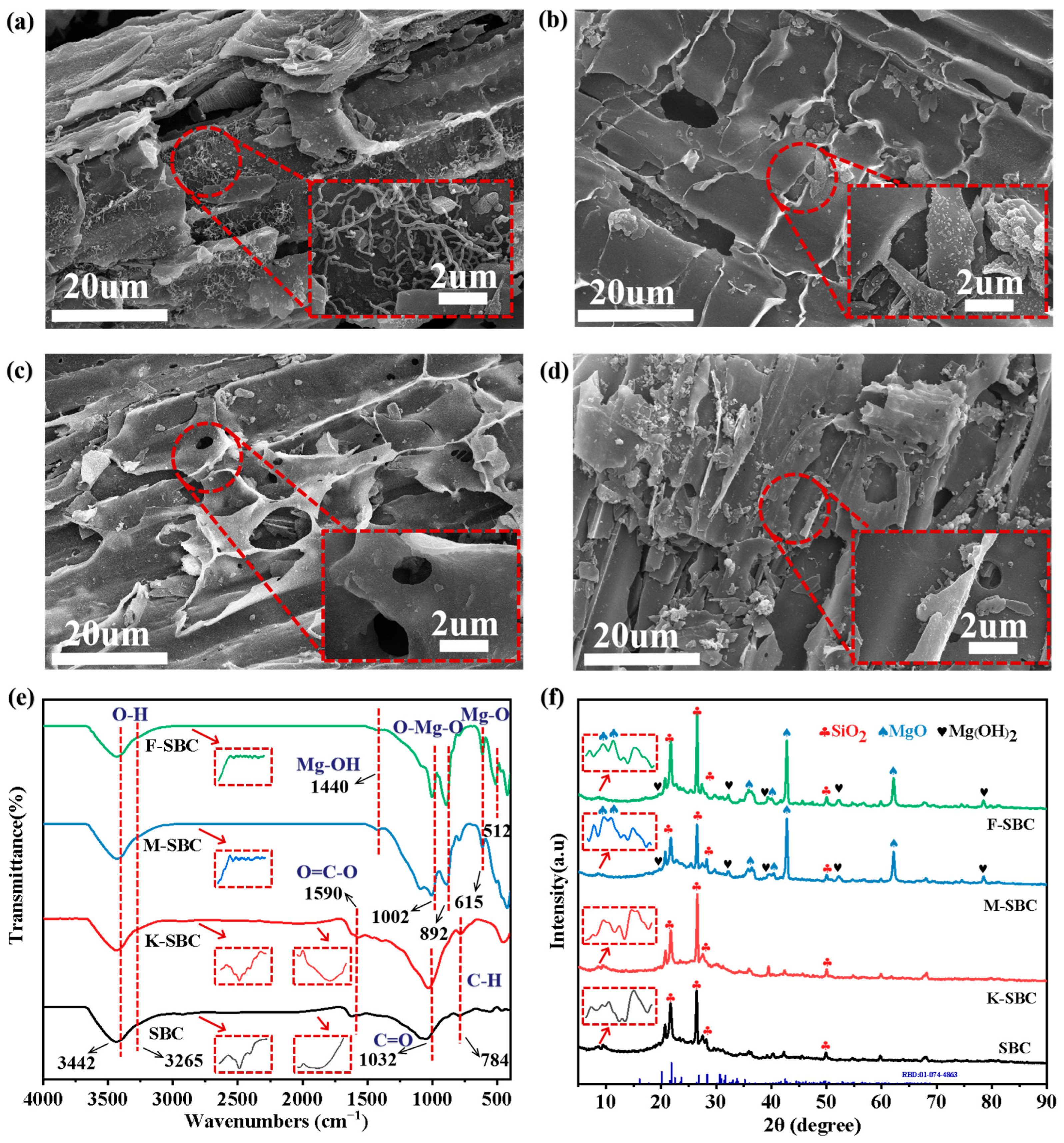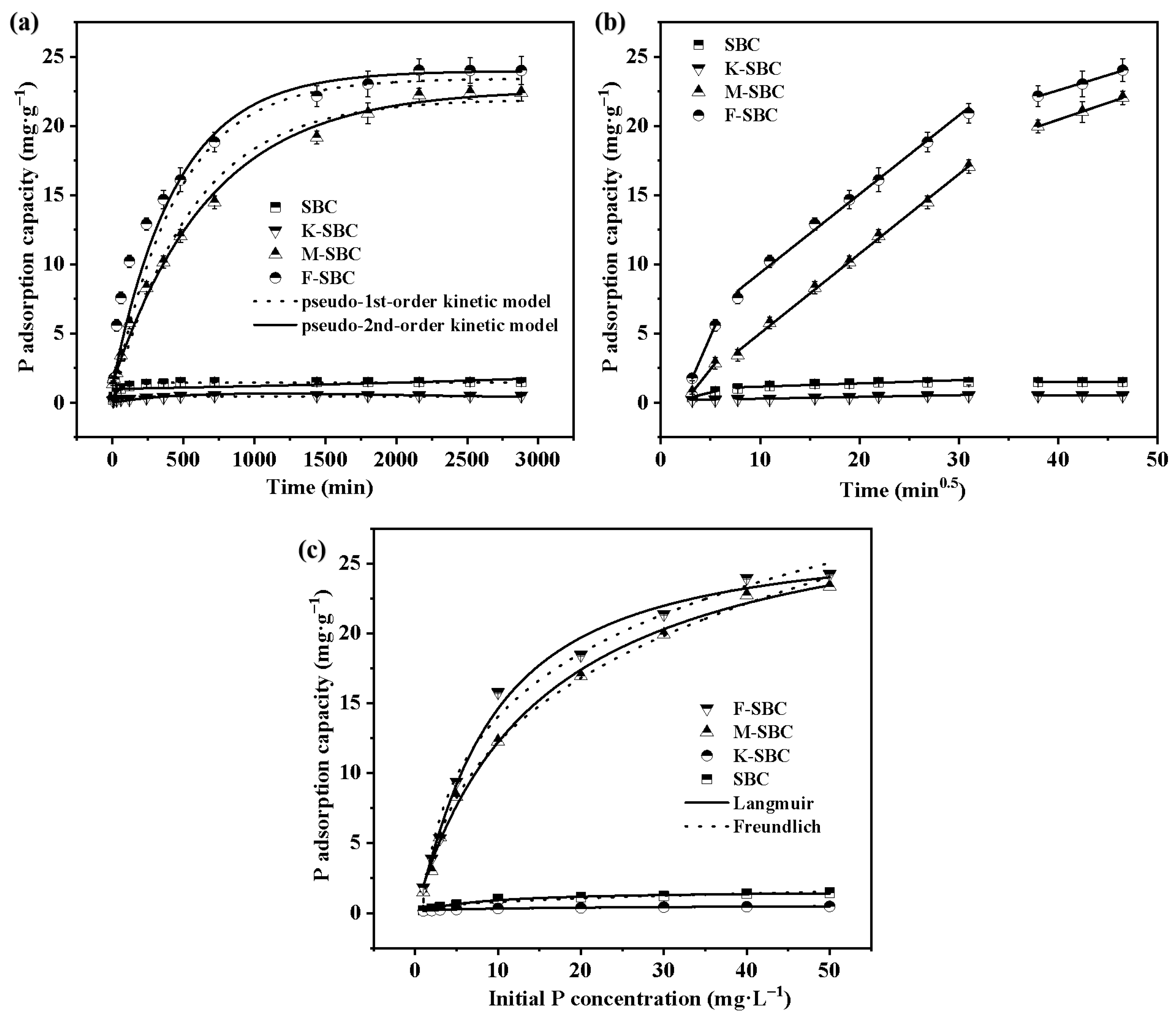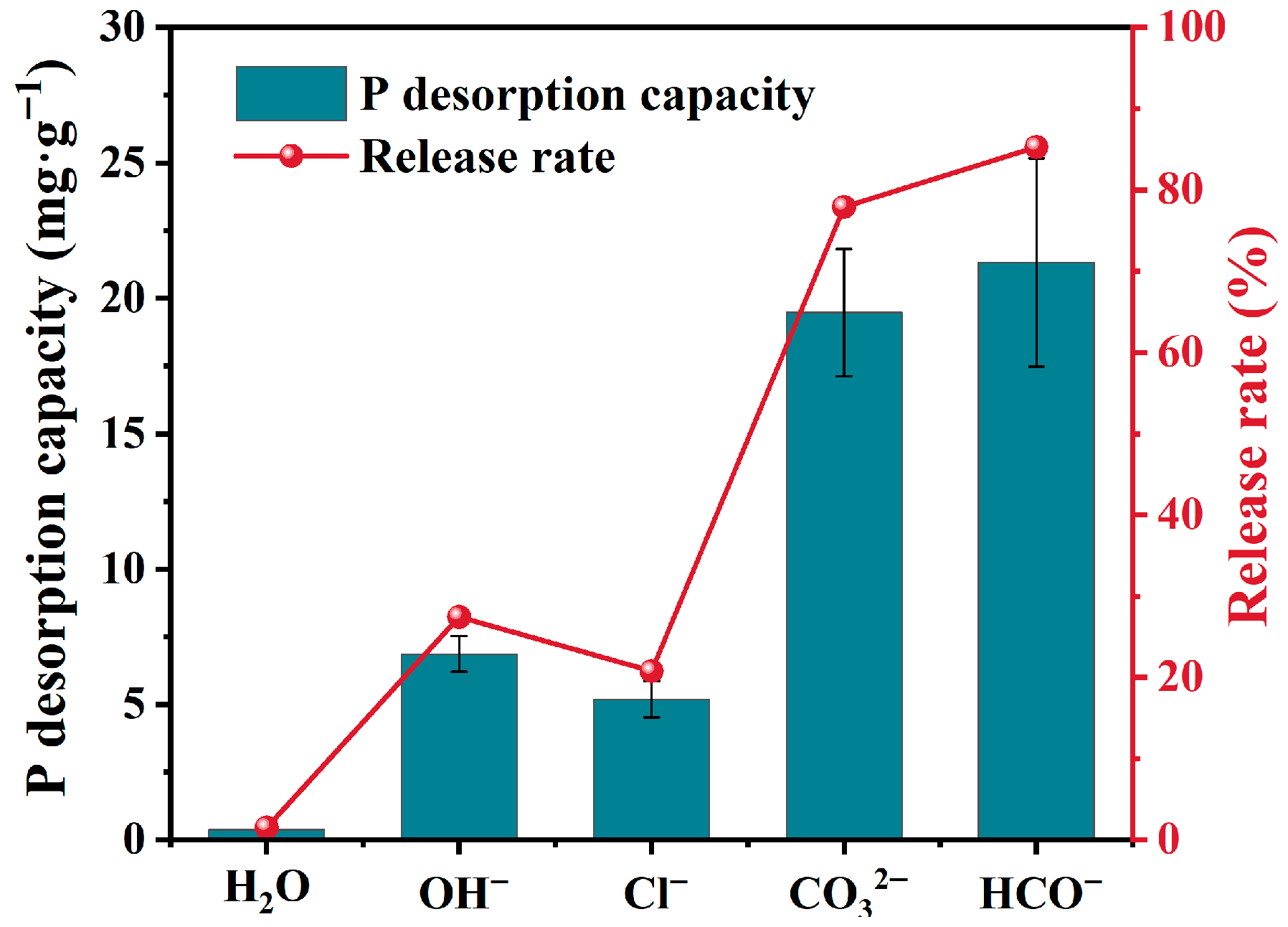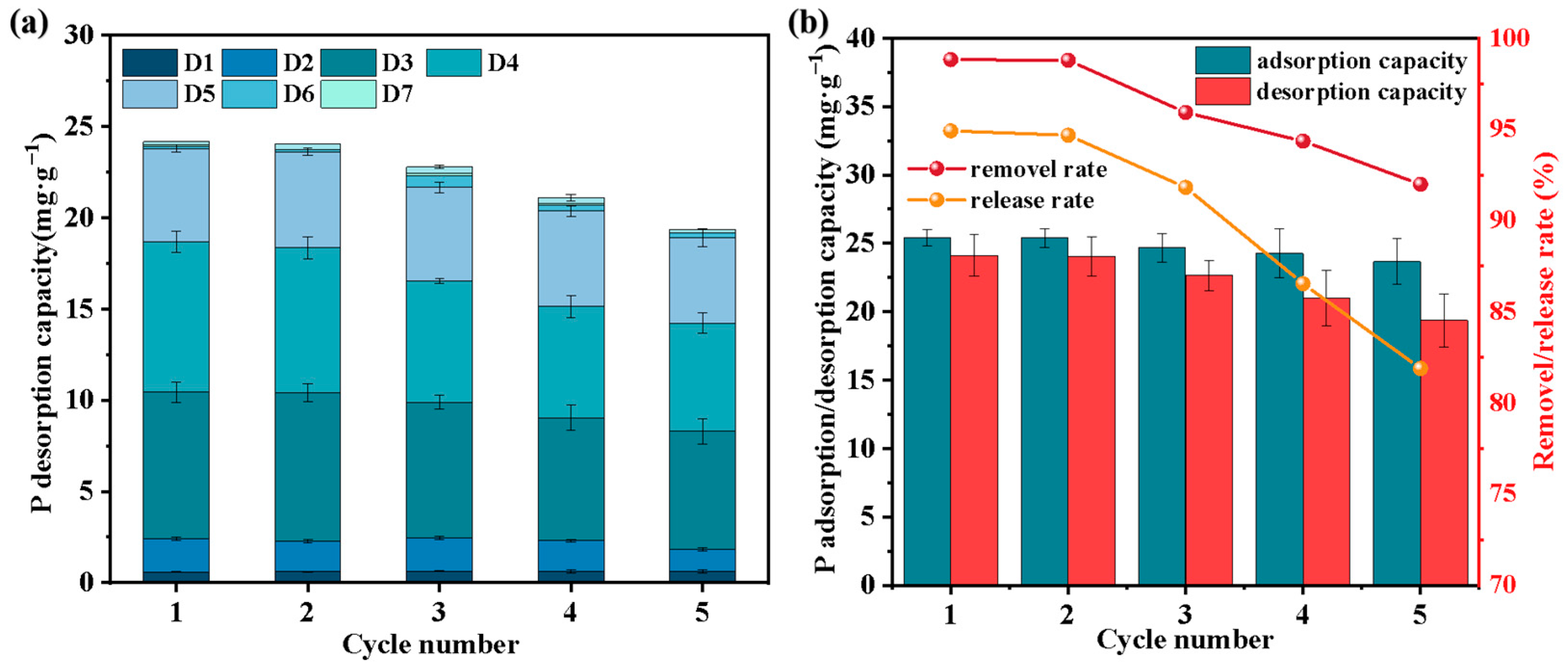Unraveling the Synergistic Mechanisms of Phosphorus Adsorption and Slow-Release on Low-Mg-Loaded Biochar Enabled by KOH Activation
Highlights
- A novel functional straw biochar (F-SBC) was engineered.
- F-SBC shows superior pH adaptability and regeneration stability.
- Synergistic KOH-activation and Mg-modification strategy was used.
- The adsorbent has great potential for practical wastewater treatment.
- Synergistic removal mechanisms including precipitation were revealed.
- Provides a effective way to design high-performance biochar materials.
Abstract
1. Introduction
2. Materials and Methods
2.1. Materials and Preparation of Pristine and Modified Biochars
2.2. Adsorption Experiment
2.3. Adsorption Kinetics Experiment
2.4. Adsorption Isotherm Experiments
2.5. Desorption Experiments
2.6. Regeneration Experiment
2.7. Characterization Methods
3. Results
3.1. Characteristics of Adsorbents
3.1.1. Morphological and Elemental Characterization
3.1.2. Porous Structure Analysis
3.1.3. Surface Functional Groups
3.1.4. Crystalline Phase Composition
3.2. Adsorption Performance of Different Biochars
3.2.1. Adsorption Kinetics
3.2.2. Adsorption Isotherms
3.3. Analysis of Influencing Factors
3.3.1. Effect of Initial pH on the Adsorption Performance
3.3.2. Effect of Coexisting Anions on the Desorption Performance
3.3.3. The Adsorption and Slow-Release Capacity Evaluation
3.4. Adsorption and Slow-Release Mechanism
4. Discussion
5. Conclusions
Supplementary Materials
Author Contributions
Funding
Data Availability Statement
Conflicts of Interest
References
- Wang, H.J.; Wang, J.; Yu, X. Wastewater irrigation and crop yield: A meta-analysis. J. Integr. Agric. 2022, 21, 1215–1224. [Google Scholar] [CrossRef]
- Lustosa Filho, J.F.; Viana, R.d.S.R.; Melo, L.C.A.; de Figueiredo, C.C. Changes in phosphorus due to pyrolysis and in the soil-plant system amended with sewage sludge biochar compared to conventional P fertilizers: A global meta-analysis. Chemosphere 2025, 371, 144055. [Google Scholar] [CrossRef]
- Mishra, S.; Kumar, R.; Kumar, M. Use of treated sewage or wastewater as an irrigation water for agricultural purposes—Environmental, health, and economic impacts. Total Environ. Res. Themes 2023, 6, 100051. [Google Scholar] [CrossRef]
- Zhou, Y.; Liu, Z.; Shan, J.; Wu, C.; Lichtfouse, E.; Liu, H. Efficient recovery of phosphate from urine using magnesite modified corn straw biochar and its potential application as fertilizer. J. Environ. Chem. Eng. 2024, 12, 111925. [Google Scholar] [CrossRef]
- Kok, D.J.D.; Pande, S.; Van Lier, J.B.; Ortigara, A.R.C.; Savenije, H.; Uhlenbrook, S. Global phosphorus recovery from wastewater for agricultural reuse. Hydrol. Earth Syst. Sci. 2018, 22, 5781–5799. [Google Scholar] [CrossRef]
- Feng, J.; Techapun, C.; Phimolsiripol, Y.; Phongthai, S.; Khemacheewakul, J.; Taesuwan, S.; Mahakuntha, C.; Porninta, K.; Htike, S.L.; Kumar, A.; et al. Utilization of agricultural wastes for co-production of xylitol, ethanol, and phenylacetylcarbinol: A review. Bioresour. Technol. 2024, 392, 129926. [Google Scholar] [CrossRef]
- Lin, Z.; Wang, R.; Tan, S.; Zhang, K.; Yin, Q.; Zhao, Z.; Gao, P. Nitrogen-doped hydrochar prepared by biomass and nitrogen-containing wastewater for dye adsorption: Effect of nitrogen source in wastewater on the adsorption performance of hydrochar. J. Environ. Manag. 2023, 334, 117503. [Google Scholar] [CrossRef] [PubMed]
- Gao, Y.; Jiang, Z.; Li, J.; Xie, W.; Jiang, Q.; Bi, M.; Zhang, Y. A comparison of the characteristics and atrazine adsorption capacity of co-pyrolysed and mixed biochars generated from corn straw and sawdust. Environ. Res. 2019, 172, 561–568. [Google Scholar] [CrossRef]
- Tran, D.T.; Pham, T.D.; Dang, V.C.; Pham, T.D.; Nguyen, M.V.; Dang, N.M.; Ha, M.N.; Nguyen, V.N.; Nghiem, L.D. A facile technique to prepare MgO-biochar nanocomposites for cationic and anionic nutrient removal. J. Water Process Eng. 2022, 47, 102702. [Google Scholar] [CrossRef]
- Tang, Z.; Gao, J.; Dong, H.; Du, Q.; Feng, D.; Cheng, J.; Li, J.; Peng, Y.; Zhang, T.; Xie, M.; et al. Targeted construction of porous biochar with well-developed pore structure for high-performance CO2 adsorption. J. Environ. Chem. Eng. 2024, 12, 114182. [Google Scholar] [CrossRef]
- Shirazinezhad, M.; Faghihinezhad, M.; Baghdadi, M.; Ghanbari, M. Phosphate removal from municipal effluent by a porous MgO-expanded graphite composite as a novel adsorbent: Evaluation of seawater as a natural source of magnesium ions. J. Water Process Eng. 2021, 43, 102232. [Google Scholar] [CrossRef]
- Xu, Y.F.; Chen, J.Y.; Yang, F.; Fang, Y.F.; Qian, G.R. Transformation of phosphorus by MgCl2 and CaCl2 during sewage sludge incineration. Environ. Sci. Pollut. 2021, 28, 60268–60275. [Google Scholar] [CrossRef]
- Yang, L.; Guo, X.; Liang, S.; Yang, F.; Wen, M.; Yuan, S.; Xiao, K.; Yu, W.; Hu, J.; Hou, H.; et al. A sustainable strategy for recovery of phosphorus as vivianite from sewage sludge via alkali-activated pyrolysis, water leaching and crystallization. Water Res. 2023, 233, 119769. [Google Scholar] [CrossRef]
- Zhang, M.; Song, G.; Gelardi, D.L.; Huang, L.; Khan, E.; Mašek, O.; Parikh, S.J. Evaluating biochar and its modifications for the removal of ammonium, nitrate, and phosphate in water. Water Res. 2020, 186, 116303. [Google Scholar] [CrossRef]
- Chen, M.; Liu, Y.; Pan, J.; Jiang, Y.; Zou, X.; Wang, Y. Low-cost Ca/Mg co-modified biochar for effective phosphorus recovery: Adsorption mechanisms, resourceful utilization, and life cycle assessment. Chem. Eng. J. 2024, 502, 157993. [Google Scholar] [CrossRef]
- Jellali, S.; Hadroug, S.; Al-Wardy, M.; Al-Nadabi, H.; Nassr, N.; Jeguirim, M. Recent developments in metallic-nanoparticles-loaded biochars synthesis and use for phosphorus recovery from aqueous solutions. A critical review. J. Environ. Manag. 2023, 342, 118307. [Google Scholar] [CrossRef] [PubMed]
- Xu, Q.; Jin, Y.; Zheng, F.; Lu, J. Exploitation of pomelo peel developing porous biochar by N, P co-doping and KOH activation for efficient CO2 adsorption. Sep. Purif. Technol. 2023, 324, 124595. [Google Scholar] [CrossRef]
- Simoes, M.C.; Hughes, K.J.; Ingham, D.B.; Ma, L.; Pourkashanian, M. Estimation of the Thermochemical Radii and Ionic Volumes of Complex Ions. Inorg. Chem. 2017, 56, 7566–7573. [Google Scholar] [CrossRef] [PubMed]
- Liu, C.; Wang, W.; Wu, R.; Liu, Y.; Kan, H.; Zheng, Y. Preparation of Acid- and Alkali-Modified Biochar for Removal of Methylene Blue Pigment. ACS Omega 2020, 5, 30906–30922. [Google Scholar] [CrossRef] [PubMed]
- Liu, B.; Liu, F.; Li, W.; Qin, W.; Wang, M.; Jia, Y.; Wang, C.; Ma, Z. Unraveling the mechanism and key role of KOH activation in phosphate adsorption by La(NO3)3/KOH-modified blue algae-derived biochar composite. J. Environ. Chem. Eng. 2025, 13, 116100. [Google Scholar] [CrossRef]
- Zhou, Z.; Luo, D.; Zhang, X.; Wang, C. Sustainable phosphorus recovery from wastewater by layered double hydroxide/biochar composites for potential agricultural application. Ind. Crops Prod. 2025, 224, 120422. [Google Scholar] [CrossRef]
- Fang, L.; Li, J.S.; Donatello, S.; Cheeseman, C.R.; Poon, C.S.; Tsang, D.C.W. Use of Mg/Ca modified biochars to take up phosphorus from acid-extract of incinerated sewage sludge ash (ISSA) for fertilizer application. J. Cleaner Prod. 2020, 244, 118853. [Google Scholar] [CrossRef]
- Wang, H.; Dai, J.; Chen, H.; Wang, F.; Zhu, Y.; Liu, J.; Zhou, B.; Yuan, R. Adsorption of phosphate by Mg/Fe-doped wheat straw biochars optimized using response surface methodology: Mechanisms and application in domestic sewage. Environ. Eng. Res. 2023, 28, 210602. [Google Scholar] [CrossRef]
- Isidoro Ribeiro, N.; Barreto Pessanha, O.; Luiza Gomes Soares Pessanha, M.; Guimarães, D. Efficient phosphate adsorption by a composite composed of Mg6Al2(CO3)(OH)16·4H2O LDH and Chitosan: Kinetic, thermodynamic, desorption, and characterization studies. Sep. Purif. Technol. 2023, 307, 122717. [Google Scholar] [CrossRef]
- Keyikoglu, R.; Khataee, A.; Yoon, Y. Layered double hydroxides for removing and recovering phosphate: Recent advances and future directions. Adv. Colloid Interface Sci. 2022, 300, 102598. [Google Scholar] [CrossRef]
- Wang, T.; Chen, X.; Ju, C.; Wang, C. Calcium signaling in plant mineral nutrition: From uptake to transport. Plant Commun. 2023, 4, 100678. [Google Scholar] [CrossRef] [PubMed]
- Wang, G.; Liu, R.; Yang, Z.; Liu, W.; Xu, X.; Zhang, S.; Cheng, Z.; Lv, G.; Xu, C.; Cai, J.; et al. Enhanced simultaneous removal of phosphate and ammonium from swine wastewater using magnetic magnesium–loaded Chinese herbal medicine residues: Performance, mechanism, and resource utilization. Bioresour. Technol. 2024, 393, 130103. [Google Scholar] [CrossRef]
- Biswas, B.; Rahman, T.; Sakhakarmy, M.; Jahromi, H.; Eisa, M.; Baltrusaitis, J.; Lamba, J.; Torbert, A.; Adhikari, S. Phosphorus adsorption using chemical and metal chloride activated biochars: Isotherms, kinetics and mechanism study. Heliyon 2023, 9, e19830. [Google Scholar] [CrossRef]
- Zhao, Z.; Wang, B.; Feng, Q.; Chen, M.; Zhang, X.; Zhao, R. Recovery of nitrogen and phosphorus in wastewater by red mud-modified biochar and its potential application. Sci. Total Environ. 2023, 860, 160289. [Google Scholar] [CrossRef] [PubMed]
- Li, K.; Zhang, D.; Niu, X.; Guo, H.; Yu, Y.; Tang, Z.; Lin, Z.; Fu, M. Insights into CO2 adsorption on KOH-activated biochars derived from the mixed sewage sludge and pine sawdust. Sci. Total Environ. 2022, 826, 154133. [Google Scholar] [CrossRef] [PubMed]
- Premchand, P.; Demichelis, F.; Galletti, C.; Chiaramonti, D.; Bensaid, S.; Antunes, E.; Fino, D. Enhancing biochar production: A technical analysis of the combined influence of chemical activation (KOH and NaOH) and pyrolysis atmospheres (N2/CO2) on yields and properties of rice husk-derived biochar. J. Environ. Manag. 2024, 370, 123034. [Google Scholar] [CrossRef] [PubMed]
- Ma, Y.; Wu, L.; Li, P.; Yang, L.; He, L.; Chen, S.; Yang, Y.; Gao, F.; Qi, X.; Zhang, Z. A novel, efficient and sustainable magnetic sludge biochar modified by graphene oxide for environmental concentration imidacloprid removal. J. Hazard. Mater. 2021, 407, 124777. [Google Scholar] [CrossRef]
- Shin, J.; Kwak, J.; Kim, S.; Son, C.; Lee, Y.G.; Kim, J.; Bae, S.; Park, Y.; Lee, S.H.; Chon, K. Highly selective recovery of phosphate ions using a novel carbonaceous adsorbent synthesized via co-pyrolysis of spent coffee grounds and steel slags: A potential phosphatic fertilizer. Chem. Eng. J. 2023, 451, 138978. [Google Scholar] [CrossRef]
- Mari Selvam, S.; Behera, B.; Chauhan, A.; Madaan, A.; Rajamanickam, R.; Akshaya, K.; Selvasembian, R. Sustainable approach of modified biochar based adsorbents towards enhanced phosphorus removal from wastewater. J. Anal. Appl. Pyrolysis 2025, 188, 107020. [Google Scholar] [CrossRef]
- Novais, S.V.; Zenero, M.D.O.; Tronto, J.; Conz, R.F.; Cerri, C.E.P. Poultry manure and sugarcane straw biochars modified with MgCl2 for phosphorus adsorption. J. Environ. Manag. 2018, 214, 36–44. [Google Scholar] [CrossRef]
- Chen, D.; Yin, Y.; Xu, Y.; Liu, C. Adsorptive recycle of phosphate by MgO-biochar from wastewater: Adsorbent fabrication, adsorption site energy analysis and long-term column experiments. J. Water Process Eng. 2023, 51, 103445. [Google Scholar] [CrossRef]
- Jiang, Y.H.; Li, A.Y.; Deng, H.; Ye, C.H.; Wu, Y.Q.; Linmu, Y.D.; Hang, H.L. Characteristics of nitrogen and phosphorus adsorption by Mg-loaded biochar from different feedstocks. Bioresour. Technol. 2019, 276, 183–189. [Google Scholar] [CrossRef]
- Guo, Z.; Zhang, D.; Ma, L.; Dai, Q.; Yang, R.; Ao, R. Magnesium modified algae biochar for phosphorus adsorption: Synthesis, experimental analysis, DFT calculations and regeneration. J. Water Process Eng. 2025, 71, 107169. [Google Scholar] [CrossRef]
- Liu, X.; Zhou, W.; Feng, L.; Wu, L.; Lv, J.; Du, W. Characteristics and Mechanisms of Phosphorous Adsorption by Peanut Shell-Derived Biochar Modified with Magnesium Chloride by Ultrasonic-Assisted Impregnation. ACS Omega 2022, 7, 43102–43110. [Google Scholar] [CrossRef]
- Zhang, X.; Xiong, Y.; Wang, X.; Wen, Z.; Xu, X.; Cui, J.; Liu, Z.; Wei, L.; An, X. MgO-modified biochar by modifying hydroxyl and amino groups for selective phosphate removal: Insight into phosphate selectivity adsorption mechanism through experimental and theoretical. Sci. Total Environ. 2024, 918, 170571. [Google Scholar] [CrossRef]
- Hui, K.; He, R.; Tian, Q.; Zhou, X.; Hou, L.; Zhang, X.; Jiang, Y.; Yao, H. Iron-based biochar materials for phosphorus recovery from agricultural runoff: Mechanism and potential application as a slow-release fertilizer. Sep. Purif. Technol. 2024, 347, 127597. [Google Scholar] [CrossRef]
- Jiang, R.Q.; Yu, G.W.; Yu, L.H.; Wang, Y.; Li, C.J.; Xing, Z.J.; Xue, X.M.; Wang, Y.; Yu, C. Migration of phosphorus in pig manure during pyrolysis process and slow-release mechanism of biochar in hydroponic application. Sci. Total Environ. 2024, 915, 170116. [Google Scholar] [CrossRef]
- Luo, Z.; Li, Y.; Pei, X.; Woon, K.S.; Liu, M.; Lin, X.; Hu, Z.; Li, Y.; Zhang, Z. A potential slow-release fertilizer based on biogas residue biochar: Nutrient release patterns and synergistic mechanism for improving soil fertility. Environ. Res. 2024, 252, 119076. [Google Scholar] [CrossRef]
- Li, L.; Chen, Q.; Zhao, C.; Guo, B.; Xu, X.; Liu, T.; Zhao, L. A novel chitosan modified magnesium impregnated corn straw biochar for ammonium and phosphate removal from simulated livestock wastewater. Environ. Technol. Innov. 2022, 26, 102519. [Google Scholar] [CrossRef]
- Tang, L.; Chen, S.; Wang, N.; Jiang, X. Comparative study of adsorption and slow-release performance and mechanism of phosphoric acid and ammonia-modified biochars on 2,4-dichlorophenoxyacetic acid. Sep. Purif. Technol. 2025, 358, 130470. [Google Scholar] [CrossRef]
- Yin, Y.; Zhao, Z.; Wang, G.; Xu, Y.; Luan, Y.; Xie, Y.; Zhao, J.; Liu, C. Nanoconfinement of MgO in nitrogen pre-doped biochar for enhanced phosphate adsorption: Performance and mechanism. Bioresour. Technol. 2024, 414, 131613. [Google Scholar] [CrossRef]
- Ghosh, S.; López, E.O.; Barbosa, A.d.N.; Huaman, N.R.C.; da Silva Filho, J.G.; Raza, S.A.; Santos, R.; Freire, F.L., Jr.; Mello, A. Comprehensive structural and surface investigation of Sb2Se3 thin-films. Surf. Interfaces 2024, 44, 103693. [Google Scholar] [CrossRef]
- Krishna, D.N.G.; Philip, J. Review on surface-characterization applications of X-ray photoelectron spectroscopy (XPS): Recent developments and challenges. Appl. Surf. Sci. 2022, 12, 100332. [Google Scholar] [CrossRef]
- Huang, Y.; Wu, Q.; Yan, J.; Chu, F.; Xu, Y.; Li, D.; Zhang, H.; Yang, S. Efficient removal and recovery of phosphate by biochar loaded with ultrafine MgO nanoparticles. Environ. Res. 2025, 266, 120518. [Google Scholar] [CrossRef] [PubMed]
- Wang, B.; Hu, X.; Li, L.; Wang, H.; Huang, H.; Wang, R.; Zhou, D.; Yuan, J.; Chen, L. Application and functionalization of toxic waste sludge-derived biochar for efficient phosphate separation from aqueous media: Toxicity diminution, robust adsorption, and inner mechanism. Chem. Eng. J. 2023, 468, 143745. [Google Scholar] [CrossRef]
- Wu, H.C.; Lin, C.C.; Yang, C.H.; Huang, Y.W.; Yeh, C.H.; Chou, Y.J.; Liu, T.C. Enhanced electrocatalytic conversion of CO2 to CO via a non-stoichiometric zinc-fluorine amorphous interface. Chem. Eng. J. 2025, 509, 161002. [Google Scholar] [CrossRef]
- Carneiro, J.S.D.S.; Lustosa Filho, J.F.; Nardis, B.O.; Ribeiro-Soares, J.; Zinn, Y.L.; Melo, L.C.A. Carbon Stability of Engineered Biochar-Based Phosphate Fertilizers. ACS Sustain. Chem. Eng. 2018, 6, 14203–14212. [Google Scholar] [CrossRef]
- Shin, J.; Lee, Y.G.; Kwak, J.; Kim, S.; Lee, S.H.; Park, Y.; Lee, S.D.; Chon, K. Adsorption of radioactive strontium by pristine and magnetic biochars derived from spent coffee grounds. J. Environ. Chem. Eng. 2021, 9, 105119. [Google Scholar] [CrossRef]
- Alqadami, A.A.; Khan, M.A.; Siddiqui, M.R.; Alothman, Z.A. Development of citric anhydride anchored mesoporous MOF through post synthesis modification to sequester potentially toxic lead (II) from water. Microporous Mesoporous Mater. 2018, 261, 198–206. [Google Scholar] [CrossRef]
- Pan, F.; Wei, H.; Huang, Y.; Guo, W.; Song, J.; Zhang, Z.; Teng, R.; Gao, M.; Jing, S.; Shi, B. Biochar-enabled phosphorus recovery from aqueous: Advances, applications and challenges. Environ. Res. 2025, 285, 122329. [Google Scholar] [CrossRef] [PubMed]
- Wang, L.; Liu, J.; Jiang, Y.; Zhang, T.; Wang, M.; Yang, D.; Qiu, F. Trash to treasure: From waste sludge to phosphorus slow-release fertilizer. J. Environ. Chem. Eng. 2025, 13, 116926. [Google Scholar] [CrossRef]
- Chanda, R.; Jahid, T.; Karmokar, A.; Hossain, B.; Moktadir, M.; Islam, M.S.; Aich, N.; Biswas, B.K. Functionalized biochar from vegetable waste for phosphorus removal from aqueous solution and its potential use as a slow-release fertilizer. Clean. Mater. 2025, 15, 100287. [Google Scholar] [CrossRef]
- Shin, J.; Kwak, J.; Kim, S.; Son, C.; Kang, B.; Lee, Y.G.; Chon, K. Enhanced selectivity and recovery of phosphate and nitrate ions onto coffee ground waste biochars via co-precipitation of Mg/Al layered double hydroxides: A potential slow-release fertilizer. Environ. Res. 2023, 231, 116266. [Google Scholar] [CrossRef] [PubMed]
- An, X.; Xu, X.; Guo, W.; Chen, Z.; Miao, Z.; Yuan, J.; Wu, Z. Bi-functional biochar-g-C3N4-MgO composites for simultaneously minimizing pollution: Photocatalytic degradation of pesticide and phosphorus recovery as slow-release fertilizer. J. Environ. Manag. 2023, 344, 118489. [Google Scholar] [CrossRef]







| Sample | BET (m2·g−1) | Pore Volume (cm3·g−1) | Pore Diameter (nm) | At.% | |||||
|---|---|---|---|---|---|---|---|---|---|
| C | O | Mg | Si | K | Ca | ||||
| SBC | 177.3884 | 0.1031 | 2.3244 | 87.4 | 10.4 | 0 | 1.7 | 0 | 0.5 |
| K-SBC | 197.0262 | 0.1118 | 2.2697 | 81.8 | 12.4 | 0 | 2.6 | 2.3 | 0.8 |
| M-SBC | 164.5370 | 0.0951 | 2.3119 | 82.0 | 9.8 | 6.1 | 1.8 | 0 | 0.2 |
| F-SBC | 137.6233 | 0.1051 | 3.0545 | 81.1 | 10.5 | 6.9 | 1.0 | 0.4 | 0.1 |
Disclaimer/Publisher’s Note: The statements, opinions and data contained in all publications are solely those of the individual author(s) and contributor(s) and not of MDPI and/or the editor(s). MDPI and/or the editor(s) disclaim responsibility for any injury to people or property resulting from any ideas, methods, instructions or products referred to in the content. |
© 2025 by the authors. Licensee MDPI, Basel, Switzerland. This article is an open access article distributed under the terms and conditions of the Creative Commons Attribution (CC BY) license (https://creativecommons.org/licenses/by/4.0/).
Share and Cite
Bu, F.; Han, L.; Guo, H.; Liang, Y.; Yan, H. Unraveling the Synergistic Mechanisms of Phosphorus Adsorption and Slow-Release on Low-Mg-Loaded Biochar Enabled by KOH Activation. Materials 2025, 18, 5214. https://doi.org/10.3390/ma18225214
Bu F, Han L, Guo H, Liang Y, Yan H. Unraveling the Synergistic Mechanisms of Phosphorus Adsorption and Slow-Release on Low-Mg-Loaded Biochar Enabled by KOH Activation. Materials. 2025; 18(22):5214. https://doi.org/10.3390/ma18225214
Chicago/Turabian StyleBu, Fengyun, Lei Han, Hongxia Guo, Yu Liang, and Haihong Yan. 2025. "Unraveling the Synergistic Mechanisms of Phosphorus Adsorption and Slow-Release on Low-Mg-Loaded Biochar Enabled by KOH Activation" Materials 18, no. 22: 5214. https://doi.org/10.3390/ma18225214
APA StyleBu, F., Han, L., Guo, H., Liang, Y., & Yan, H. (2025). Unraveling the Synergistic Mechanisms of Phosphorus Adsorption and Slow-Release on Low-Mg-Loaded Biochar Enabled by KOH Activation. Materials, 18(22), 5214. https://doi.org/10.3390/ma18225214








